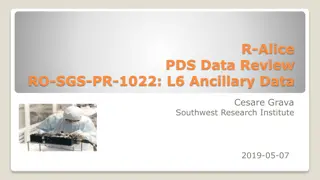
ALICE Detector System Overview
Discover the ALICE sub-detectors and Detector Control System (DCS) at the heart of the ALICE experiment. Learn how the DCS ensures safe and efficient operation, with control monitoring and SCADA systems in place. Explore the architecture, software components, and tools driving the ALICE DCS setup.
Download Presentation

Please find below an Image/Link to download the presentation.
The content on the website is provided AS IS for your information and personal use only. It may not be sold, licensed, or shared on other websites without obtaining consent from the author. If you encounter any issues during the download, it is possible that the publisher has removed the file from their server.
You are allowed to download the files provided on this website for personal or commercial use, subject to the condition that they are used lawfully. All files are the property of their respective owners.
The content on the website is provided AS IS for your information and personal use only. It may not be sold, licensed, or shared on other websites without obtaining consent from the author.
E N D
Presentation Transcript
By Alaa ElSadieque
The ALICE sub-detectors can be grouped into several categories, according to their primary role in the experiment. > Tracking is performed by six silicon layers of the Inner Tracking System (ITS) > High Momentum Particle Identification Detector (HMPID) > Global features of the reactions are measured by a number of smaller detectors: The experiment forward region is covered by the Forward Multiplicity detector FMD the Photon Multiplicity Detector (PMD) the compact Zero Degree Calorimeters (ZDC) which are located in the LHC machine tunnel. The Muon spectrometer consists of the tracking Muon Chambers(MCH) Muon Trigger Chambers (MTR).
The Detector Control System (DCS )is responsible for safe and correct operation of the ALICE experiment.
The ALICE DCS It DCS has been designed to: Assure a high running efficiency by reducing downtime to a minimum. Maximizes the number of readout channels operational at any time. measures and stores all parameters necessary for efficient analysis of the physics data.
control Monitoring They are provided in such a way, that the whole experiment can be operated from a single workspace in the ALICE control room.
SCADA The core of the controls system is a commercial Supervisory Control and Data Acquisition (SCADA) system.
The control system will allow hardwired software
ALICE DCS ARCHITECTURE Software Components and Tools System Layout The Field Layer The Supervisory Layer The Finite State Machines Partitioning The User Interface
Software Components and Tools The core of the controls system is a commercial Supervisory Control and Data Acquisition (SCADA) system named PVSS Software framework built on top of PVSS allows for data exchange with external services and systems through a standardized set of interfaces, mostly based on the CERN LHC Data Interchange Protocol (DIP). The core of the framework is built as a common effort between the LHC experiments and CERN EN/ICE-SCD section, in the context of a Joint COntrols Project (JCOP). The main tools cover Finite State Machine (FSM), alarm handling, configuration, archiving, access control, user interfaces,data exchange and communication.
ALICE framework is used by the sub-detector experts to build their own control applications, such as high voltage control, front-end electronics control, etc. About 140 such applications are finally integrated into a large and global ALICE control system.
System Layout The ALICE DCS system plane.
The whole DCS can be seen as a combination of two planes, a systems plane and an operations plane. The systems plane is responsible for the execution of the commands, it assures the communication between the components and it provides the data archival. The operations plane is a logical layer built on top of the systems plane. It provides a hierarchical representation of the DCS subsystems and it assures the coherent execution of control commands.
The Field Layer The ALICE DCS field layer gathers data from sub-detectors and provides services. With 150 sub-systems and around 1200 devices, efforts are made for hardware standardization to facilitate long-term support. The OPC protocol is the chosen standard for device communication. The FEE sub-system within the field layer has detector-specific hardware. To standardize individual detector FEE operation, the Front End Device (FED) was created, utilizing a standardized interface. Communication between FED and PVSS uses the DIM protocol from CERN. The FED also serves devices without OPC access. The FEE's scale and complexity pose a challenge, with over 1,000,000 channels to control and monitor. Around 800 single board computers are mounted on detectors, and sampled values are grouped to minimize network traffic during processing.
The Field Layer The ALICE DCS field layer manages devices collecting data from sub-detectors, with 150 subsystems and about 1200 devices standardized using the OPC protocol. The FEE sub-system, unique to each detector, is standardized through the Front End Device (FED) for operation and communication with PVSS via the DIM protocol. The Controls Layer comprises computers and PLCs, running PVSS with OPC or FED servers. About 100 PVSS systems with over 1000 managers operate ALICE. PVSS's decentralized architecture allows load balancing and building distributed systems for data sharing and synchronization. Each detector has PVSS systems integrated into a large distributed system for ALICE.
The Supervisory Layer The DCS tasks in ALICE are executed by Worker Nodes (WN), specialized computers that don't support interactive work. Operators use dedicated servers, known as Operator Nodes (ON), which offer standardized user interfaces, forming the supervisory layer. User interfaces on ONs are remotely connected to individual detector systems on WNs. This design separates interactive tasks (e.g., plotting values) from control tasks, offering protection against critical system overload. Excessive load from any user interface is automatically blocked, ensuring the stability of critical systems.
The Finite State Machines The behavior and functionality of each DCS component in ALICE are described using Finite State Machines (FSM) through the CERN SMI++ toolkit. Standardized state diagrams, deployed across all sub- systems, simplify the representation of system operations. The FSM operates on the operations plane, built on the systems plane. Each detector defines a hierarchical structure, starting from channels and device modules up to complete sub-systems, extending to the ALICE top-level. Objects in this structure have defined stable states, and transitions can be triggered by operators or automatically in response to anomalies.
This architecture enables automatic and centralized operation. A single operator can send commands that propagate through the hierarchy, executing pre- programmed actions. The operator's command set is minimized, reflecting essential ALICE operational needs. The FSM mechanism ensures synchronized execution of commands and actions across targeted components. PVSS on the systems plane physically executes actions, and FSM on the operations plane reports status changes back to the operator. The global status is computed as a combination of states from all sub-systems.
Partitioning The SMI++ toolkit implements a partitioning mechanism that enhances system capabilities and provides flexibility. Each part of the hierarchical tree can be detached from the main system and operated independently. This allows multiple operators to work in parallel, each managing a different sub-system. Additionally, the logical view of the system can be created independently of the systems plane. Partitioning, such as masking hierarchy sub-trees or creating separate trees from the main ALICE structure, doesn't impact the execution of PVSS systems. When a part of the hierarchy is disconnected or masked, its FSM reporting no longer propagates to the top node. However, to ensure the safe operation of the experiment, the central operator is alerted about anomalies across the entire system through the alert mechanism on the systems plane. If necessary, the central operator can assume full control of any sub-tree and perform required tasks.
The User Interface The Graphics User Interface (GUI) in ALICE is a standardized component distributed and utilized across all detectors. Positioned as the top layer in the ALICE DCS architecture, it ensures a consistent look and feel for all components, facilitated by supplied tools and guidelines. The GUI plays a crucial role in providing a unified interface for users interacting with the DCS. The GUI in ALICE serves as a comprehensive tool, offering features such as a hierarchy browser, alert overview, access to Finite State Machines (FSM), and status monitoring.
Commands initiated through the GUI are transmitted to various components using either the FSM mechanism for standard actions or directly via PVSS for expert actions. An integrated role-based access control mechanism is in place to ensure protection against inadvertent errors [8]. This access control system helps manage user permissions based on roles, enhancing the security and reliability of DCS operations.
The data handling capacity of ALICE DCS significantly exceeds that of previous control systems. It involves approximately 1200 network-attached devices and 270 VME and power supply crates, forming the field layer infrastructure. At the commencement of a physics run, up to 6GB of data is loaded from the DCS database to detector devices. This data encompasses PVSS recipes, including nominal values of device parameters, alert limits, and FEE settings, amounting to configuring one million parameters for ALICE's readiness for a physics run. PVSS continually monitors all controlled parameters, reading about 300,000 values per second through OPC and FED servers. To minimize data traffic, first-level filtering is implemented, allowing only values exceeding pre- programmed thresholds to be injected into PVSS systems, achieving a 10-fold reduction factor.
Each processed value in the PVSS system is initially compared with the nominal one. If the difference exceeds the limit, an alert is generated and displayed on operator screens. Depending on severity, automatic actions might be triggered. Values designated for archival by system experts are transferred to the DCS archival database, with an additional level of filtering. Only values falling outside a band defined around the previously archived value are recorded, contributing to the reduction of storage requirements. Subsequently, a new band is defined around this recorded value.






















